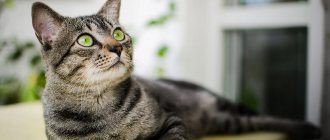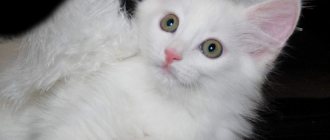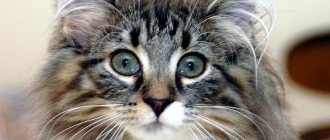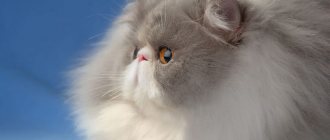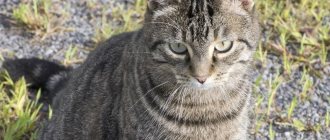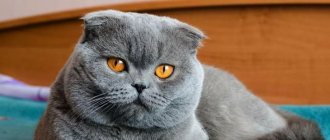What will you learn from the article?
- Shorthair cat breeds
- Semi-longhair cat breeds
- Long-haired cat breeds
- Hairless cat breeds
Fluffy and hairless, short-legged and long-legged, tailless and decorated with plumes - more than 100 breeds have already received official recognition, but literally every day new breeds of cats appear.
All cat breeds are divided into:
- Shorthair
- Semi-longhair
- Longhair
- Hairless cats
Shorthair cat breeds
Abyssinian cat
This cat breed is one of the most ancient. The Ethiopian beast (this is also the name of the beauty) is a cat of rare intelligence and rare obstinacy. The breed is famous for its exceptional colors - wild, red (sorrel or cinnamon), blue and fawn are characteristic of the Abyssinian. Ideally, each hair of her fur is triple ticked. Photos of the descendants of the cat Zula, the first Abyssinian brought to Europe, do not convey all the wild charm of the representatives of this breed.
Furry Pet Identification
We all know very well that domestic cats can be purebred, non-pedigreed or simply “Moggy”. Purebred pets are distinguished by certain qualities, external features, and characteristics that distinguish them from others. As a rule, they are bred by breeders, strictly observing standard qualities. This includes the size of the animal, color, exterior characteristics of the body, eye color, length of fur, tail, etc.
But it is very difficult to determine a breed by just one criterion; it is important to correlate at least several necessary qualities
Based on a set of certain exterior characteristics
Cats of different breeds have both distinctive and similar external features. Therefore, by correctly assessing the appearance of the animal, you can at least approximately understand who is in front of you: a cat of some breed or an ordinary “moggy”. How to determine the breed of a cat, knowing its external features? We invite you to consider the most interesting and most distinctive features that will be inherent and visible in both an adult cat and a kitten.
| Part of the body | Peculiarity | Possible breed |
| Body and body structure |
| Exotic or Persian breed; Savannah, Maine Coon, Norwegian Forest. |
| Ears |
|
|
| Tail | the tail is short. | |
| Paws | short, squat. | Munchkin. |
| Wool | short but curly coat; long and curly; long and straight; short smooth. |
Ashera, Abyssinian. |
| Color | dark color with white paws and muzzle; solid blue or silver color without spots; sand color; wild coloring, presence of spots, stripes. | Snowshoe, Burma, Ragdoll; Korat, Russian Blue, Scottish Fold, Chartreuse, Nibelung; Abyssinian cat, Somalia, Havanabrown, Tiffany-Chantilly; Siberian, Bengal, Maine Coon, Egyptian Mau, Savannah, Safari, Serengeti. |
According to behavioral characteristics
Behavior and habits are another way to find out the breed of a cat. The fact is that with the correct “pure-bred” crossing, all character traits are inherited. Therefore, cats of the same breed have similar characteristics. For example, cats of the Russian Blue breed are monogamous and handed over to their owner. Siamese cats, Savannah cats, Asherah cats, Abyssinian cats and others are endowed with sharp and even slightly wild habits.
The Persian cat, for example, is easy to recognize by its behavior, as it is docile and friendly. Doesn't like to be alone and will follow you around. They become very attached to humans and love to be held. But these cats are more exotic breeds, for example, the Turkish Van is not very accepting of communication, but loves to swim. Self-sufficient, but affectionate, very smart and reserved, even kittens of the Maine Coon and Egyptian Mau breeds.
By photo
To recognize a cat’s breed from a photograph, you need to know very well the main distinguishing features and at least have a little understanding of felinology. Otherwise it will be difficult, but quite possible. Look carefully at the photo of a cat or kitten, highlight some of its most remarkable features and compare it with the description and suitable parameters of different breeds. If there are similarities, you should assume that this is the representative in front of you. Of course, the most reliable way is to seek advice from a specialist.
Semi-longhair cat breeds
Balinese cat
These cats never grow to be giants; they are usually small or very small. The Balinese were born in Thailand, but this does not prevent them from communicating well with the whole world. You still have to look for such an open cat, striving to love and be loved!
Cymric
The Cymric cat comes from Canada. Some consider it a long-haired version of the Manx, but Canadians are sure that they have their own breed and it has the right to exist! Stocky, muscular and round are the main characteristics of the Cymric breed. They are also trainable and easy to bathe, as they simply adore water and water procedures.
Kurilian Bobtail
This is the Russian version of the short-tailed cat. The pom-pom tail, frost resistance and canine habits are the unofficial standard of the Kuril Bobtail breed. The length of the tail is different for each representative of the breed, traditionally varying from 2 to 8 vertebrae. The absence of a tail at all is a disqualifying sign.
LaPerm
Again a rex cat breed with wavy hair. Laperm is both American blood and oriental spices. In addition to curly hair, breeders note the silence of laperms. These are not the cats that wake you up in the morning with deep cries, but the ones that pull you out of your sleep with affectionate rubbing of the owner.
Munchkin
The Ulybaka cat is a munchkin cat. The length of its knife is three times shorter than the length of its body. A dachshund cat sometimes behaves like a kangaroo cat - it sits on its short hind legs and props up its body with a strong tail. Munchkins arrived in our open spaces only in 2001 and so far munchkins are not particularly popular.
Features of caring for cats with large eyes
The presence of large eyes in a pet often implies susceptibility to ophthalmological diseases, so such cats require special care.
Eye care
To keep the upper layers of the eye protected from infection and dryness, tear fluid is constantly produced. In breeds with large eyeballs, increased secretion production occurs, which leads to the formation of crusts and marks on the fur in the orbital area. This situation requires more frequent hygiene. To carry out the procedure, special lotions are used to gently wash the contaminated areas, especially in the corner of the eye.
Feeding cats with big eyes
Veterinarians recommend feeding your pet with professional food designed for a specific breed. This is due to the fact that each type of animal has its own characteristics.
If the owner has chosen natural food, the cat’s diet is agreed upon with the veterinarian.
Combing
Breeds with long hair usually require regular grooming. It is recommended to comb your pet once a week to prevent the formation of tangles. Short-haired breeds are brushed a little less often - once every two to three weeks.
Long-haired cat breeds
Himalayas
The Himalayan Colorpoint is very similar to the Persian cat, but the latter is never colorpointed. Another difference from the Persian cat is that the Himalayan cat is more active and playful. Long-haired cats get bored decorating the world with themselves and they are happy to run after a sunbeam.
Persian cat
Oh, the oldest and most popular! Yes, the creature, descended from the cat Scheherizade, must be treated with special respect. The snub-nosed cat lifts its nose for any reason and does not really like fuss around itself. According to the standard, there are about 100 varieties of Persian cat colors, but all these cats are similar in type of build - they are strong and massive.
Origin of dwarf breeds
The efforts of breeders are aimed exclusively at improving the bright appearance. There is no point in training cats to catch mice, since this is not what their future owners will buy them for. Over the past 30 years, a stereotype has developed that a domestic cat should be a small, cute, eternal kitten, even at a conscious age. Numerous catteries in America and Europe began to diligently develop a selection of beautiful miniature cats that would delight their owners with a cheerful and playful character until old age.
Little-studied and fairly young breeds have a number of disadvantages:
- instability of crossing results (it is not always possible to obtain a kitten that fully meets the breed standards);
- paucity of material on genetic pathologies;
- limited gene pool.
Nevertheless, small cat breeds are actively developing and, for sure, breeders will be able to achieve good results in the near future. American specialists do this best, and today there are about 15 species of mini-cats that are the result of a gene mutation or hybrids of several breeds. The only type of miniature cat that has not undergone major genetic changes is the Singapore breed.
Persian
A cat with erect ears of small size is a Persian, a very beautiful breed, the history of whose origin has not yet been definitively revealed. Some scientists attribute to her a family connection with steppe cats, wild inhabitants of Asia, others believe that the direct ancestor of the Persians is the Pallas cat, which is also characterized by miniature ears. The distinctive features of the breed are :
- The body is large, with low legs, a muscular chest and developed shoulders.
- Medium sized fluffy tail.
- Wide set ears.
- Small snub nose.
- The average weight of an adult animal is about 7 kg.
- The coat is very long, more than 10 cm, thick but thin. A tuft of hair is most often present between the claws.
The owner of such a beautiful animal should prepare himself for daily care of long hair, otherwise it will mat and the cat will look sloppy. However, as an alternative, you could consider purchasing an Exotic Persian, an attractive breed with a soft, plush, short coat.
© shutterstock
